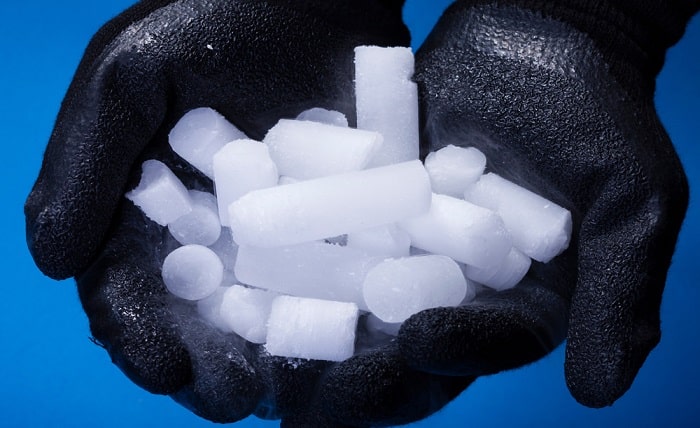Dry Ice: Everything You Need to Know About Its Uses, Benefits, and Safety Tips

Dry ice is the solid form of carbon dioxide (CO₂) and is commonly used for its cooling properties. Unlike regular ice, dry ice sublimates directly from a solid to a gas, skipping the liquid phase. This unique characteristic of dry ice makes it incredibly useful in situations where liquid residue is undesirable. Due to its extremely low temperature of -78.5°C (-109.3°F), dry ice can quickly cool or freeze items. The science behind dry ice is based on CO₂ being pressurized and cooled to form a solid, which then returns to its gaseous state when exposed to ambient temperatures.
Dry Ice: Common Uses in Transportation and Storage
One of the most common uses of dry ice is in the transportation and storage of perishable goods. Since dry ice doesn’t melt into water, it keeps items dry and frozen during transit. The food industry heavily relies on dry ice to ship frozen meat, seafood, and dairy products over long distances. Medical shipments such as vaccines and lab samples also use dry ice for temperature control. Airlines and courier services often choose dry ice over regular ice packs because dry ice provides longer-lasting and more consistent cooling without creating moisture.
Dry Ice: Industrial Applications and Cleaning Solutions
Dry ice is not only used for cooling but also plays a significant role in industrial cleaning. A process called dry ice blasting uses dry ice pellets accelerated at high speeds to clean machinery, molds, and production equipment. This method is non-abrasive, non-toxic, and environmentally friendly. Dry ice blasting does not leave behind residue, making it ideal for cleaning sensitive components. Industries such as aerospace, automotive, and electronics have embraced dry ice as a superior cleaning solution. Because it evaporates after use, dry ice is an efficient choice for areas where water or chemical cleaners are unsuitable.
Dry Ice: Creating Spectacular Special Effects in Entertainment
Dry ice is widely recognized for its dramatic fog-like effect when placed in warm water. This makes dry ice a favorite in theatrical productions, concerts, and film sets. The dense, white vapor that dry ice produces is safe when used in well-ventilated areas and adds an air of mystery or magic to visual displays. Halloween parties, haunted houses, and stage shows frequently rely on dry ice to enhance the ambiance. Magicians and illusionists also use dry ice for smoke effects during performances. The affordability and effectiveness of dry ice make it a go-to option for special effects professionals.
Dry Ice: Important Safety Tips and Handling Guidelines
While dry ice has many benefits, it must be handled with care. Because of its extreme cold, direct skin contact with dry ice can cause frostbite or burns. Always use insulated gloves or tongs when handling dry ice. Additionally, dry ice should be stored in a well-ventilated area, as it releases carbon dioxide gas as it sublimates, which can displace oxygen in enclosed spaces and pose a suffocation risk. Never store dry ice in airtight containers because the pressure build-up can cause them to explode. By following safety guidelines, users can enjoy the benefits of dry ice without any hazards.
Dry Ice: DIY Experiments and Fun Science Projects
Dry ice is popular for educational science experiments due to its exciting physical properties. Teachers and students can conduct demonstrations like inflating balloons using sublimation gas, creating dry ice bubbles, or simulating comets. These experiments with dry ice are not only visually impressive but also provide a hands-on learning experience about gases, pressure, and temperature. Parents can use dry ice to introduce children to basic chemistry and physics concepts in a fun, interactive way. However, proper adult supervision is always recommended when performing any dry ice experiment to ensure safety.
Dry Ice: Environmental Impact and Disposal Methods
When discussing dry ice, it’s important to address its environmental impact. Dry ice is made from recycled CO₂, often captured during industrial processes, which means it doesn’t contribute additional greenhouse gases to the atmosphere. Since it sublimates into CO₂ gas, dry ice doesn’t leave any solid or liquid waste. To dispose of dry ice safely, it should be allowed to sublimate in a well-ventilated area where the gas can dissipate. Never dispose of dry ice in sinks, toilets, or trash cans. By understanding its environmental footprint, users can make informed decisions when using dry ice in various settings.
Conclusion
Dry ice is a remarkable substance with a wide array of uses in science, industry, transportation, and entertainment. Its unique ability to sublimate, combined with its intense cooling power, makes dry ice invaluable for shipping perishables, performing industrial cleaning, and generating stunning visual effects. With proper handling and awareness of safety protocols, dry ice can be used efficiently and responsibly. Whether you’re a business owner, event planner, educator, or curious learner, dry ice offers endless possibilities that combine practicality with a touch of science fiction.
FAQs
1. What exactly is dry ice made of?
Dry ice is made of solidified carbon dioxide (CO₂), which changes from solid to gas at -78.5°C without becoming a liquid.
2. Can dry ice be used to keep food cold?
Yes, dry ice is ideal for keeping food cold or frozen during storage and transport, especially when moisture is not desired.
3. Is dry ice safe to touch with bare hands?
No, direct contact with dry ice can cause severe burns or frostbite. Always use gloves or tongs when handling dry ice.
4. How long does dry ice last?
The lifespan of dry ice depends on the quantity and storage conditions, but it typically lasts 18–24 hours in an insulated cooler.
5. Can dry ice be used indoors?
Yes, dry ice can be used indoors, but the area must be well-ventilated to avoid carbon dioxide buildup, which can be dangerous.




